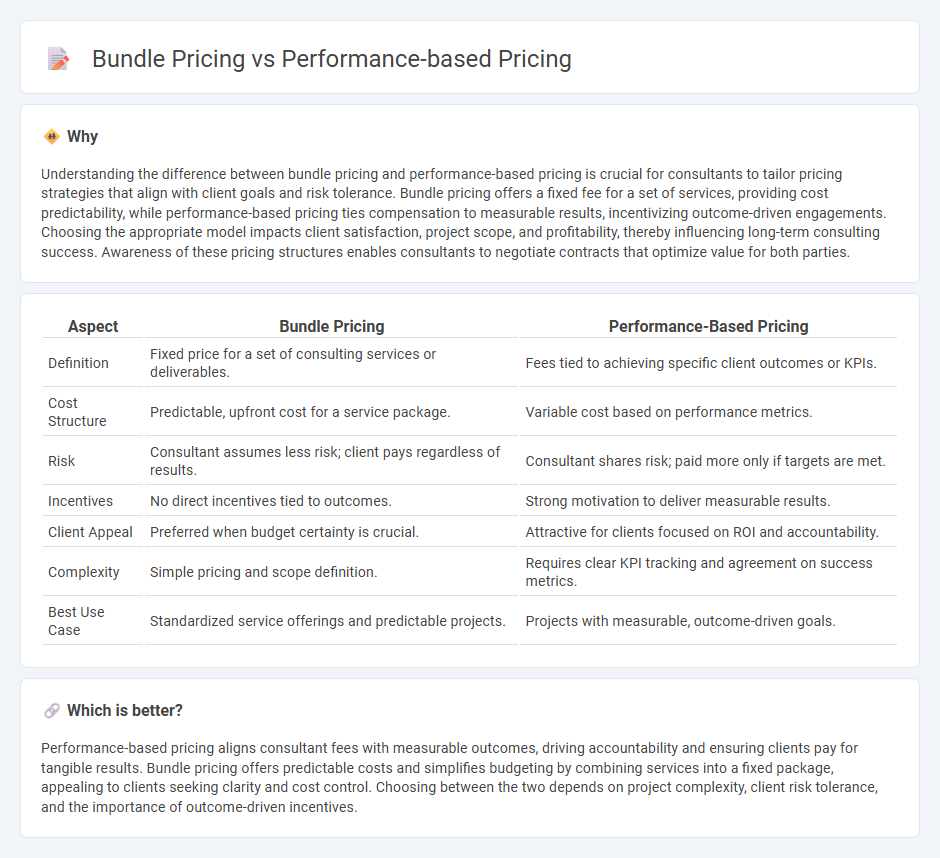
Bundle pricing combines multiple consulting services into a single package, offering clients cost savings and simplified billing. Performance-based pricing links fees directly to measurable outcomes, aligning consultant incentives with client success. Explore the advantages and ideal applications of each pricing model to determine the best fit for your consulting needs.
Why it is important
Understanding the difference between bundle pricing and performance-based pricing is crucial for consultants to tailor pricing strategies that align with client goals and risk tolerance. Bundle pricing offers a fixed fee for a set of services, providing cost predictability, while performance-based pricing ties compensation to measurable results, incentivizing outcome-driven engagements. Choosing the appropriate model impacts client satisfaction, project scope, and profitability, thereby influencing long-term consulting success. Awareness of these pricing structures enables consultants to negotiate contracts that optimize value for both parties.
Comparison Table
| Aspect | Bundle Pricing | Performance-Based Pricing |
|---|---|---|
| Definition | Fixed price for a set of consulting services or deliverables. | Fees tied to achieving specific client outcomes or KPIs. |
| Cost Structure | Predictable, upfront cost for a service package. | Variable cost based on performance metrics. |
| Risk | Consultant assumes less risk; client pays regardless of results. | Consultant shares risk; paid more only if targets are met. |
| Incentives | No direct incentives tied to outcomes. | Strong motivation to deliver measurable results. |
| Client Appeal | Preferred when budget certainty is crucial. | Attractive for clients focused on ROI and accountability. |
| Complexity | Simple pricing and scope definition. | Requires clear KPI tracking and agreement on success metrics. |
| Best Use Case | Standardized service offerings and predictable projects. | Projects with measurable, outcome-driven goals. |
Which is better?
Performance-based pricing aligns consultant fees with measurable outcomes, driving accountability and ensuring clients pay for tangible results. Bundle pricing offers predictable costs and simplifies budgeting by combining services into a fixed package, appealing to clients seeking clarity and cost control. Choosing between the two depends on project complexity, client risk tolerance, and the importance of outcome-driven incentives.
Connection
Bundle pricing and performance-based pricing connect by aligning cost structures to deliver measurable value, where bundled services are priced collectively while performance metrics dictate final payment adjustments. This integration incentivizes consultants to exceed predefined targets, ensuring clients receive comprehensive solutions with outcomes tied directly to compensation. Combining these strategies enhances transparency and optimizes both client satisfaction and consultant accountability.
Key Terms
Value Metrics
Performance-based pricing aligns costs with measurable outcomes such as user engagement, revenue growth, or conversion rates, ensuring customers pay according to value delivered. Bundle pricing combines multiple products or services at a single price, optimizing perceived value but potentially masking individual component worth. Explore detailed comparisons to determine which pricing strategy best leverages value metrics for your business growth.
Scope of Services
Performance-based pricing ties costs directly to the achievement of specific results or outcomes, ensuring clients pay only for measurable success within defined service parameters. Bundle pricing offers a fixed rate for a comprehensive package of services, often combining multiple features or products to provide overall value without isolating individual service performance. Explore more to understand which pricing model aligns best with your service scope and business objectives.
Risk Sharing
Performance-based pricing aligns costs with measurable outcomes, reducing financial risk by ensuring payments reflect actual value delivered. Bundle pricing consolidates multiple products or services at a fixed price, transferring risk predominantly to the seller who must manage costs within the package. Explore deeper insights on how risk sharing impacts strategic pricing decisions.
Source and External Links
What is Performance-Based Pricing? - DealHub - Performance-based pricing is a model where payment is tied to achieving specific, measurable outcomes such as sales growth or lead generation, aligning buyer and seller interests around clear KPIs and shifting financial risk to the provider.
Is Performance-Based Pricing the Right Price for You? - Baker Library - This pricing model aligns buyer and seller goals, acts as insurance against over- or underpaying by linking payment to actual measurable performance, and fosters deep communication to handle complex trade-offs between parties.
How to Introduce Performance-Based Pricing in SaaS - Monetizely - In SaaS, performance-based pricing ties fees to documented results like conversions or cost savings, improving customer retention but requires clearly measurable outcomes, predictable performance, and strong data tracking to implement effectively.
 dowidth.com
dowidth.com